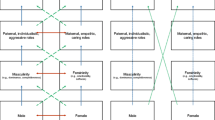Abstract
We compared gender-role egalitarianism in two domains: employment and social roles. We also investigated the influence of four variables—gender, ethnicity (Asian and non-Asian), scores on the Personal Attributes Questionnaire (PAQ), and the perceived importance of men's social privileges—on egalitarianism in each domain. Participants (205 male and female college students of varying ethnicity) were more egalitarian in the employment than in the social domain. Women were more egalitarian than men, but this gender difference was greater in the employment domain. Asian Americans were less egalitarian than non-Asians only in the social domain. Expressiveness score on the PAQ predicted higher egalitarianism, whereas the perceived importance of men's social privileges was negatively related to egalitarianism. Theoretical explanations are discussed.
Similar content being viewed by others
References
Beere, C. A., King, D. W., Beere, D. B., & King, L. A. (1984). The Sex-Role Egalitarianism Scale: A measure of attitudes toward equality between the sexes. Sex Roles, 10, 563–576.
Eagly, A. H. (1987). Sex differences in social behavior: A social-role interpretation. Hillsdale, NJ: Erlbaum.
Eagly, A. H., Wood, W., & Diekman, A. (2000). Social role theory of sex differences and similarities: A current appraisal. In T. Eckes & H. M. Trautner (Eds.), The developmental social psychology of gender (pp. 123–174). Mahwah, NJ: Erlbaum.
Employment Policy Foundation. (2002, August 21). News release. Retrieved September 17, 2002, from http://www.epf.org/media/newsreleases/2002/nr20020821.htm
Glick, P., & Fiske, S. T. (1996). The Ambivalent Sexism Inventory: Differentiating hostile and benevolent sexism. Journal of Personality and Social Psychology, 70, 491–512.
Glick, P., & Fiske, S. T. (2001). An ambivalent alliance: Hostile and benevolent sexism as complementary justifications for gender inequality. American Psychologist, 56, 109–118.
Helmreich, R. L., Spence, J. T., & Wilhelm, J. A. (1981). A psychometric analysis of the Personal Attributes Questionnaire. Sex Roles, 7, 1097–1108.
King, L. A., & King, D. W. (1993). Manual for SRES: An instrument to measure attitudes toward gender-role equality. Port Huron, MI: Sigma Assessment Systems.
King, L. A., & King, D. W. (1997). Sex-role Egalitarianism Scale: Development, psychometric properties, and recommendations for future research. Psychology of Women Quarterly, 21, 71–87.
Laner, M. R., & Ventrone, N. A. (1998). Egalitarian daters/traditionalist dates. Journal of Family Issues, 19, 468–477.
Niemi, R. G., Mueller, J., & Smith, T. W. (1989). Trends in public opinion: A compendium of survey data. New York: Greenwood.
Pratto, F., Stallworth, L. M., Sidanius, J., & Siers, B. (1997). The gender gap in occupational role attainment: A social dominance approach. Journal of Personality and Social Psychology, 72, 37–53.
Rose, S., & Frieze, I. H. (1993). Young singles' contemporary dating scripts. Sex Roles, 28, 499–509.
Sidanius, J., Pratto, F., & Bobo, L. (1994). Social dominance orientation and the political psychology of gender: A case of invariance? Journal of Personality and Social Psychology, 67, 998–1011.
Smith, T. W. (1999). The emerging 21st century American family. (GSS Social Change Report No. 42). Chicago: National Opinion Research Center, University of Chicago.
Solomon, L. Z., Minton, J., Calano, L., Raber, R., & Rapoport-Taylor, B. (1985). Being female and liking it: An empirical study. Academic Psychology Bulletin, 7, 241–252.
Spence, J. T., & Buckner, C. E. (2000). Instrumental and expressive traits, trait stereotypes, and sexist attitudes. Psychology of Women Quarterly, 24, 44–62.
Spence, J. T., & Hahn, E. D. (1997). The Attitudes Toward Women Scale and attitude change in college students. Psychology of Women Quarterly, 21, 17–34.
Spence, J. T., Helmreich, R., & Stapp, J. (1974). The PersonalAttributes Questionnaire: A measure of sex role stereotypes and masculinity-femininity. Catalog of Selected Documents in Psychology, 43–44.
Williams, J. E., & Best, D. L. (1990). Sex and psyche: Gender and self viewed cross-culturally. Newbury Park, CA: Sage.
Author information
Authors and Affiliations
Corresponding author
Rights and permissions
About this article
Cite this article
Anderson, S.J., Johnson, J.T. The Who and When of “Gender-Blind” Attitudes: Predictors of Gender-Role Egalitarianism in Two Different Domains. Sex Roles 49, 527–532 (2003). https://doi.org/10.1023/A:1025836807911
Issue Date:
DOI: https://doi.org/10.1023/A:1025836807911




